FM synthesis is the key to unlocking a vast world of unique and expressive sounds in your music production.
In this comprehensive guide, we’ll explore the fundamentals, techniques, and expert tips to help you master Frequency Modulation (FM) synthesis.
Get ready to dive deep into:
- The basics of FM synthesis ✓
- Understanding waveforms & frequency ratios ✓
- Crafting evolving pads, textures, basses, and leads ✓
- More advanced techniques ✓
- Expert tips for mastering FM synthesis ✓
With this knowledge at your fingertips, you’ll be well on your way to harnessing the full potential of FM synthesis in your music production journey.
Table of Contents
- What Is FM Synthesis?
- History of FM Synthesis
- FM Synthesizers in Music Production
- The Building Blocks of FM Synthesis
- Frequency Modulation vs. Subtractive Synthesis
- The Role of Operators in FM Synthesis
- Delving Deeper into FM Synthesis
- FM Synthesis Techniques
- The FM Matrix
- Expert Tips to Mastering FM Synthesis
- FM Synthesis: Final Thoughts
What Is FM Synthesis?
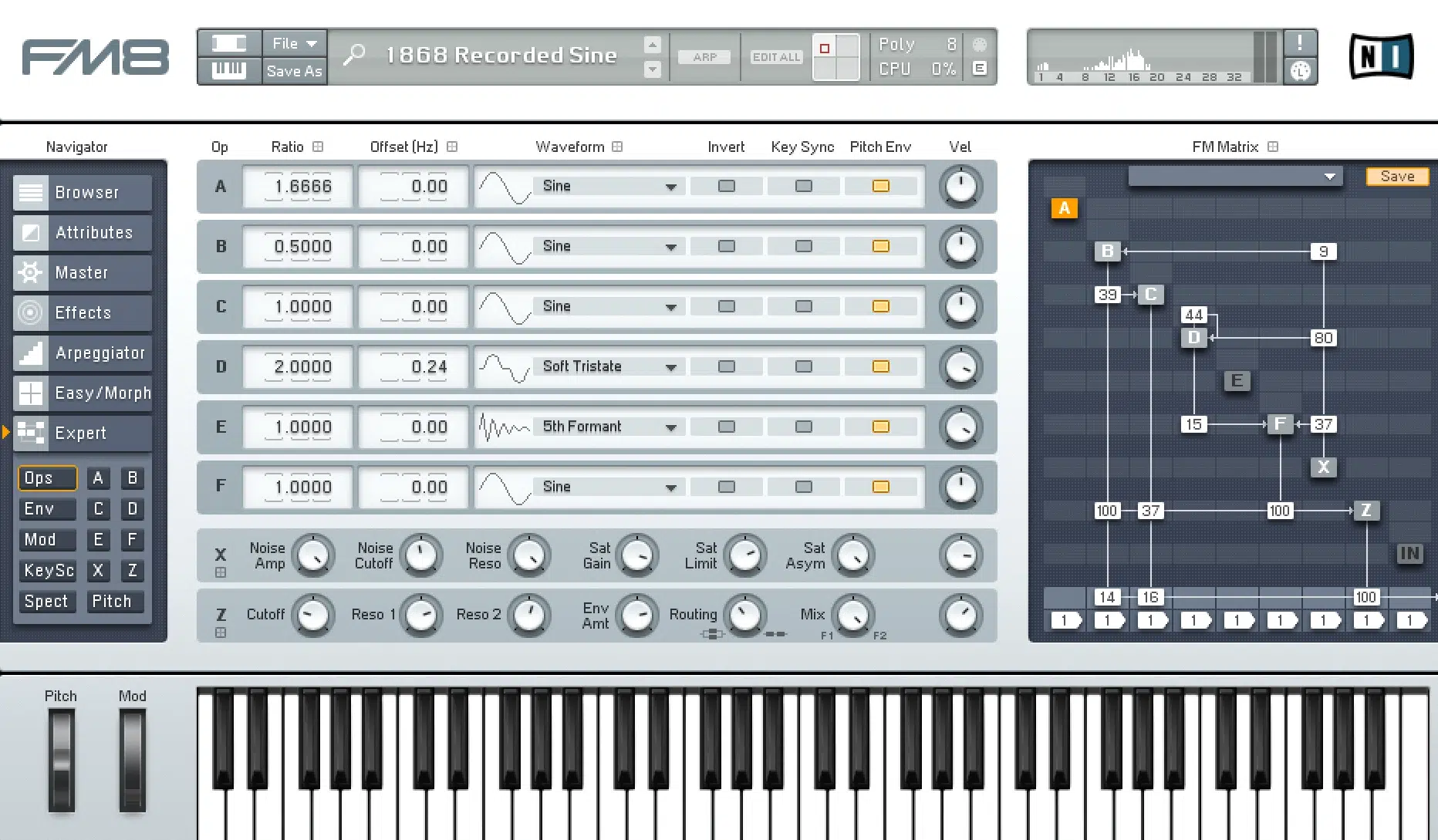
FM synthesis, or Frequency Modulation synthesis, is a powerful and versatile method of sound generation that has become a staple in modern music production.
At its core, FM synthesis works by using multiple sine wave oscillators, known as operators, to modulate the frequency of another oscillator.
This process results in the creation of complex waveforms and unique timbres, offering a wide range of sonic possibilities.
Unlike subtractive synthesis, which relies on filtering and shaping harmonics generated by oscillators, FM synthesis is all about creating complex sounds by modulating frequencies.
A fundamental aspect of FM synthesis is the relationship between the carrier wave and the modulating signal.
The carrier wave is the primary waveform that gets modulated by another waveform, called the modulator.
By adjusting the frequency ratio between these two waveforms, you can produce anything from simple sine waves to intricate and evolving timbres.
When working with FM synthesis, it’s essential to understand the role of operators, as they are the building blocks of your sound.
Each operator can act as a carrier signal, a modulator signal, or both, depending on its configuration.
By using different operator arrangements, you can explore frequency modulation in depth and generate a wide variety of sounds, from classic FM synths to cutting-edge textures.
History of FM Synthesis
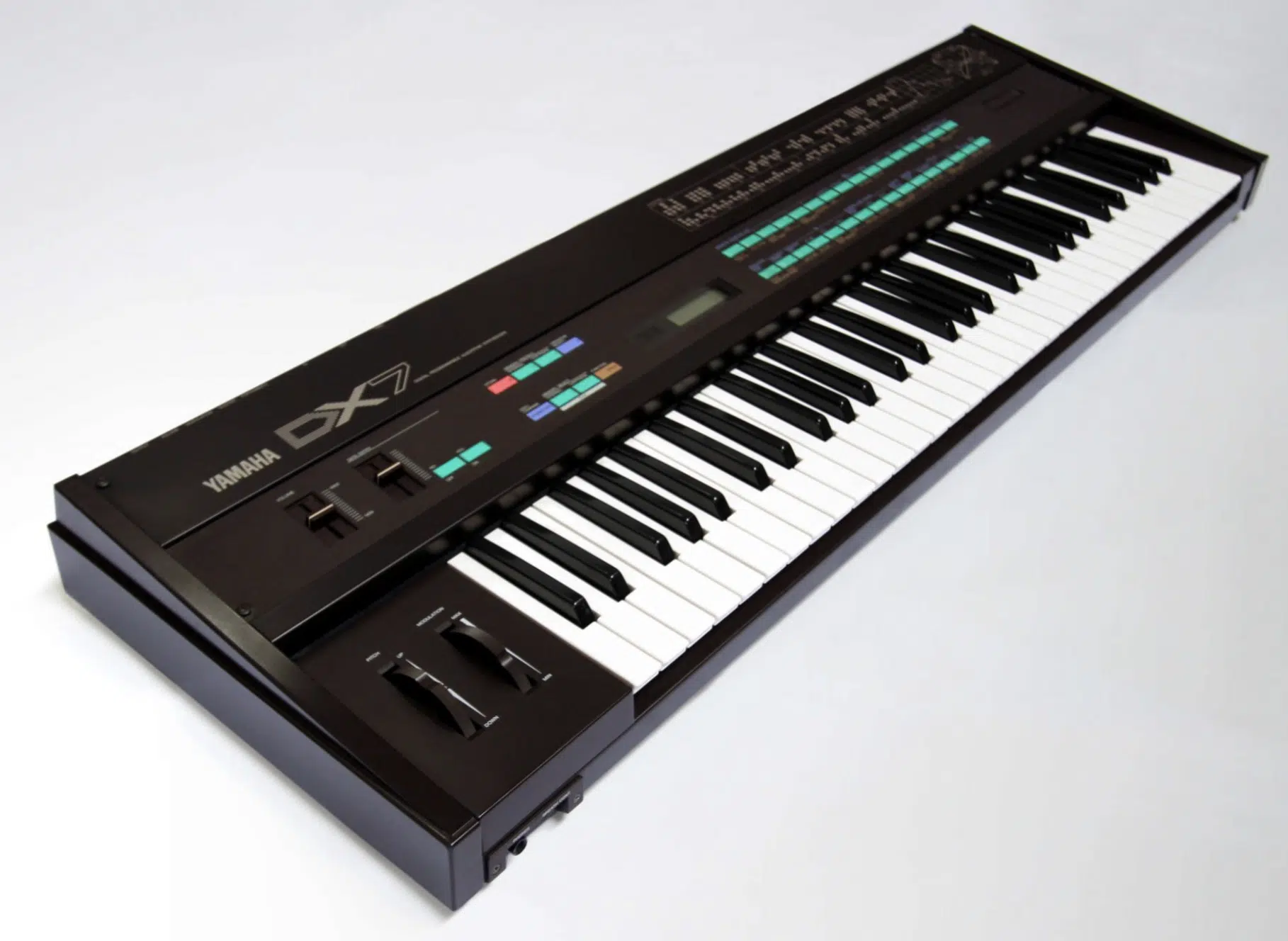
FM synthesis was first developed by John Chowning in the late 1960s, but it wasn’t until the early 1980s that it took the music world by storm.
This is when Yamaha released the legendary Yamaha DX7, an iconic FM synthesizer that transformed the music industry with its unique sounds, such as electric pianos, basses, and the bell sound.
Classic FM synths like the Yamaha DX7 revolutionized the music industry with their distinctive FM sound, introducing a new sonic palette that continues to inspire.
Today, FM synthesis continues to be a vital part of music production, with modern FM synths like Ableton’s Operator and Native Instruments’ FM8 leading the charge.
FM Synthesizers in Music Production
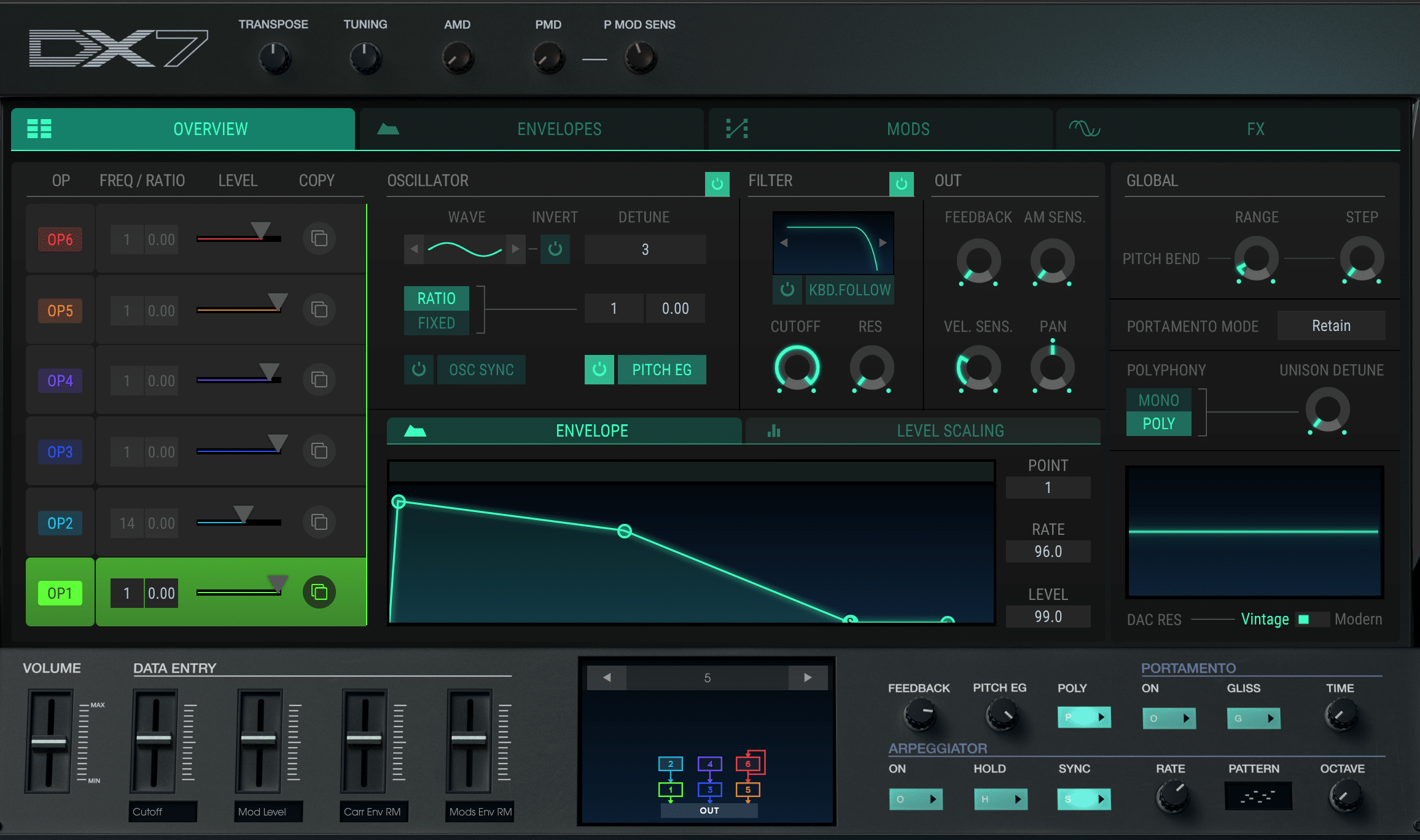
As music producers, we’re always searching for new ways to create unique and expressive sounds.
FM synthesis offers a vast sonic palette that can be used to craft sounds that are simply unattainable with other forms of synthesis, such as subtractive synthesis.
The ability to create complex tones and textures makes FM synthesis an essential tool in any music producer’s arsenal.
Another reason FM synthesis is great for music production is its versatility.
From warm pads and punchy basses to sharp leads and intricate soundscapes, FM synthesis has you covered.
Whether you’re working on a dancefloor banger or an ambient masterpiece, FM synthesis can provide the sounds you need to bring your music to life.
FM synthesis is also relatively efficient when it comes to processing power.
This means you can use multiple instances of FM synths in your music production projects without bogging down your computer.
In a world where CPU resources are precious, this is a significant advantage.
The Building Blocks of FM Synthesis
Before we dive into the intricacies of FM synthesis, it’s crucial to understand the basic building blocks that make it all possible.
At the heart of FM synthesis are simple waveforms, which are the raw materials used to create sounds.
The most basic waveform is:

- The Basic Sine Wave 一 Consists of a single frequency with no harmonics. Sine waves are smooth and pure, making them the perfect building blocks for FM synthesis. By modulating sine waves at different frequencies, you can create complex waveforms and a vast array of sounds.
Other simple waveforms used in synthesis include:

- The Square Wave 一 Have a distinct, hollow sound due to their harmonic series
- Sawtooth Waves 一 Have a bright and buzzy character thanks to their rich harmonic content

The square wave and sawtooth waveforms are not as commonly used in FM synthesis as sine waves.
However, it’s important to note that incorporating other simple waveforms like the square wave, can lead to even more interesting and complex sounds (like unique timbres).
Experimenting with different combinations of sine, square, and sawtooth waves is an excellent way to explore the full potential of FM synthesis.
Frequency Modulation vs. Subtractive Synthesis
FM synthesis and subtractive synth are two of the most popular synthesis techniques in music production.
While they share some similarities, they are fundamentally different in how they create and shape sounds.
Subtractive synthesis works by starting with a rich harmonic waveform, such as a square or sawtooth wave, and then using filters to remove or “subtract” certain frequencies from the sound.
This technique is excellent for creating warm, analog-style sounds and is the basis for classic synthesizers like the Moog Minimoog and the Roland Jupiter-8.
On the other hand, FM synthesis begins with simple waveforms, like sine waves, and uses modulation in order to modulate the included waveforms.
This adds harmonics and helps to creative those sought-after, complex timbres.
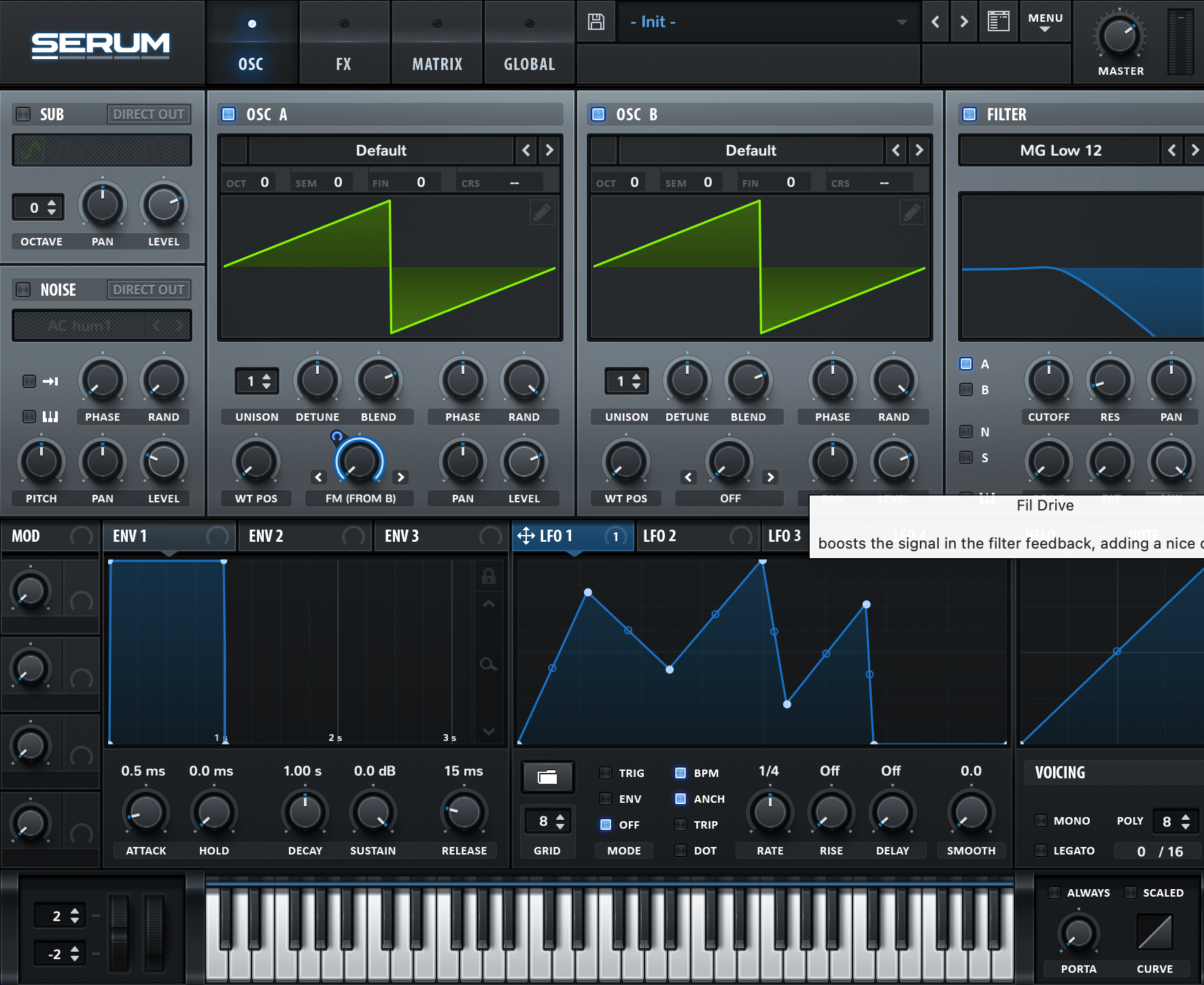
This approach can result in a broader range of sounds, from a bell tone and electric piano to evolving pads and face-melting leads.
FM synthesis is often seen as more versatile and capable of producing more intricate and unique sounds compared to subtractive synthesis.
Additionally, it delves into the world of physical modeling as well.
Understanding the differences between frequency modulation and subtractive synthesis can help you choose the right tool for the job and unlock new creative possibilities.
As you explore frequency modulation in greater depth, you’ll discover new ways to combine operators and modulate parameters, unlocking a world of sonic possibilities.
The Role of Operators in FM Synthesis
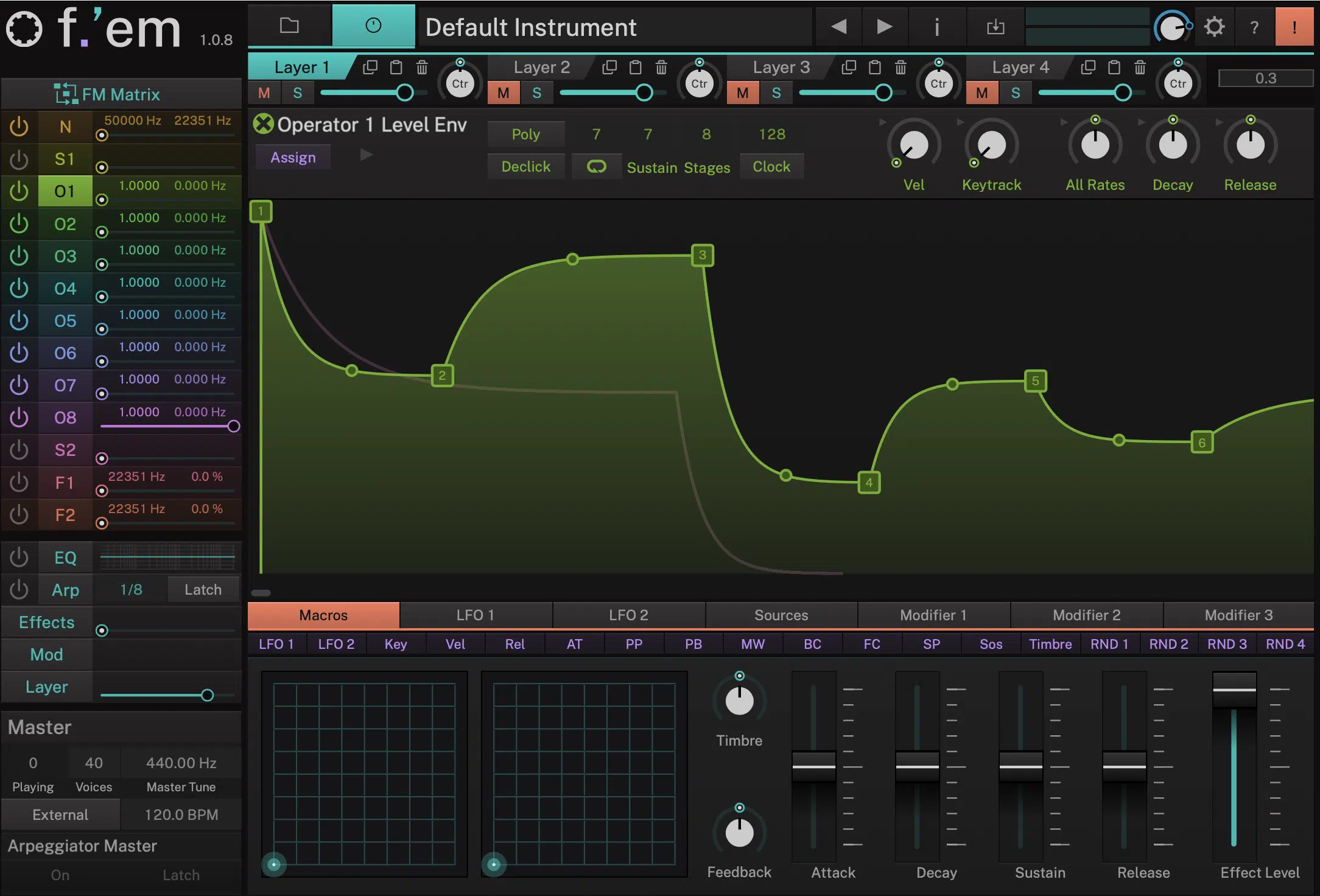
An operator is essentially a sine wave oscillator combined with an envelope generator.
In an FM synth, operators can either act as:
- Carriers 一 which produce the audible sound.
- Modulators 一 which affect the frequency of the carrier signal.
The interaction between carrier and modulator operators is what gives FM synthesis its unique sonic characteristics.
In a simple FM synthesis setup, one operator might act as the carrier, while another operator acts as the modulator.
The modulator’s output, or the modulating signal, is used to modulate the frequency of the carrier signal, resulting in a more complex waveform with new harmonic content.
As you add more operators to the mix, the possibilities for sound creation increase exponentially.
With multiple operators and complex envelope shapes, you can create complex chains of modulation, resulting in even more intricate and enthralling sounds.
NOTE: Most FM Synths expand beyond the typical ADSR Envelopes by incorporating more stages. These allow for more intricate, meticulous shapes and modulations, and may even differ from the typical times.
For example, an attack time of 1 second may be indicated as a “rate” function.
This gives you the opportunity to include more complex Timing variations, otherwise impossible with a traditional ADSR Envelope.
Other, more basic FM parameters may simply add an ADSHR Envelope, with the added flexibility of a “hold” stage.
Understanding the role of FM operators and how they interact is the key to mastering FM synthesis and unlocking its full potential.
Delving Deeper into FM Synthesis
Now that we’ve covered the basics, it’s time to delve deeper into the inner workings of FM synthesis.
-
The Fundamental Frequency & Harmonic Series
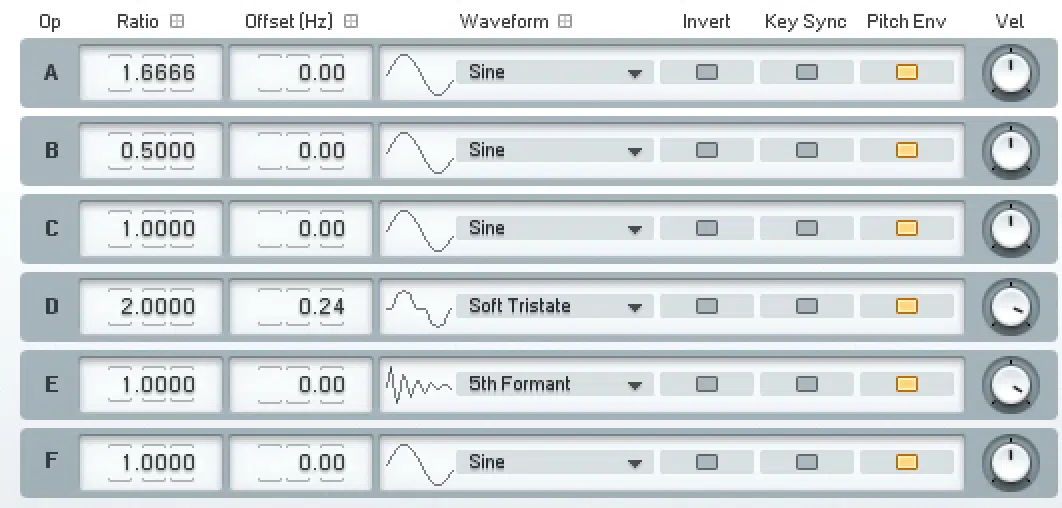
A fundamental frequency is the lowest frequency of a periodic waveform.
In FM synthesis, this frequency serves as the basis for creating more complex and elaborate sounds.
The harmonic series is a collection of frequencies that occur as integers/multiples of a specific fundamental frequency.
For example, if the fundamental frequency is 100 Hz, the harmonic series would include frequencies like 200 Hz, 300 Hz, 400 Hz, and so on.
These harmonics play a crucial role in defining the tonal characteristics of a sound.
By introducing different harmonics through modulation, you can create rich and diverse sounds in your FM synths.
By adjusting these parameters, you can control the presence and intensity of harmonics.
In turn, you can create everything from simple sine waves with minimal harmonic content to meticulous and evolving timbres rich in harmonic detail.
PRO TIP: Creating sounds with non-integers are just as crucial as whole number ratios. Furthermore, using a mix of harmonic and non-harmonic operator ratio values are key to creating epic and mind-blowing sounds.
If you’re looking for additional methods in which to create mind-blowing sounds, don’t forget to check out these expert hip-hop production tips.
-
The Frequency Ratio

Frequency ratio is another essential concept in FM synthesis.
The ratio between the carrier frequency and the modulator frequency determines the harmonic content of the resulting sound.
A frequency ratio of 1:1, for example, means that the modulator frequency is equal to the carrier frequency.
However, by increasing the modulator frequency to a value of (for instance) 1.2 will result in a simple vibrato effect.
This is referred to as “beating” in the world of FM synthesis.
As the frequency ratio increases, more complex harmonic structures emerge.
For instance, a frequency ratio of 2:1 or a non-harmonic ratio, such as 3:1, can create harmonic-rich bell tones or metallic textures.
By experimenting with different frequency ratios, you can explore the full spectrum of sounds achievable with FM synthesis and fine-tune your sound design.
NOTE: Not all frequency ratios produce harmonically pleasing results. Some ratios can result in dissonant or noisy sounds, which might be undesirable for certain musical applications.
However, these “imperfect” ratios can also lead to interesting and unique soundscapes when used creatively.
Particularly when used in conjunction with short envelopes to impart a non-harmonious attack to a lead.
-
The Relationship Between Carrier & Modulator Signals
The interaction between carrier and modulator signals is at the heart of FM synthesis.
The carrier signal is the audible sound you hear, while the modulator signal shapes the harmonic content of the carrier by modulating its frequency.
The depth of modulation (how much the modulator signal affects the carrier signal) is determined by the modulator’s level.
This level is usually not constant and, while its overall level can be scaled, the envelope accounts for its shape, depth, and movement over time.
When the modulator level is low, the resulting sound may be close to a simple sine wave.
As the modulator level increases, the sound becomes more complex, with additional harmonics and intricate textures, known as “side bands.”
The relationship between carrier and modulator signals is essential to comprehending how FM synthesis works and how to create unique music.
By adjusting the modulator’s frequency, level, and envelope, you can dramatically change the character of the sound and discover new sonic possibilities.
FM Synthesis Techniques
Now that you have a solid understanding of the fundamentals of FM synthesis, it’s time to dive into some practical techniques to help you make the most of this powerful sound design tool.
1. Creating Expressive and Dynamic Sounds
One of the keys to creating expressive and dynamic sounds with FM synthesis is understanding how to use envelopes effectively.
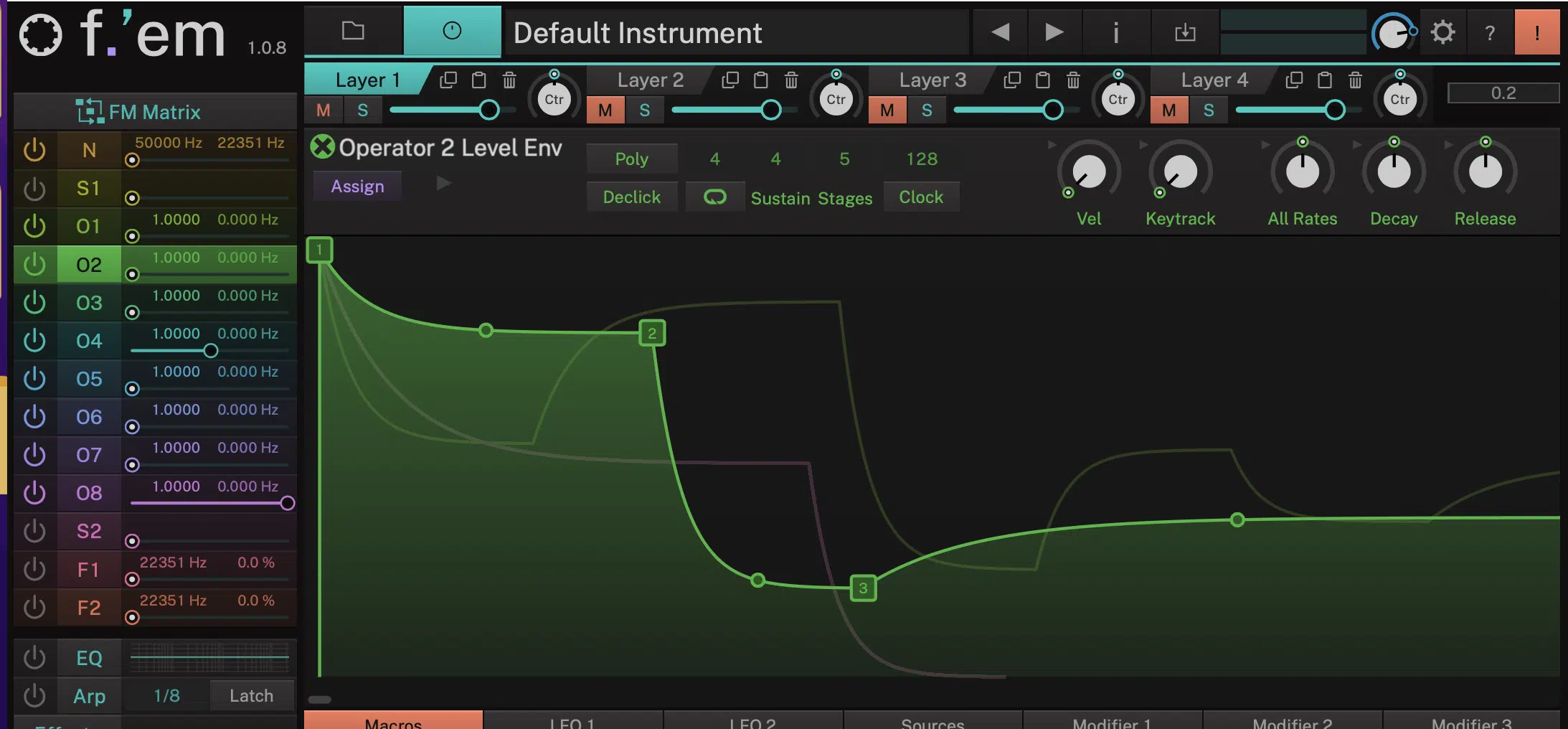
- Envelopes 一 Used to control the amplitude and frequency of the carrier and modulator signals over time, allowing you to shape the sound’s attack, sustain, and release.
To create expressive sounds, try using different envelope shapes for your carrier and modulator operators.
For example, you could use a fast attack and decay envelope for the carrier, while using a slow attack and long release envelope for the modulator.
This will result in a sound that evolves over time, with the modulator adding harmonics as the sound evolves.
Another classic way to add expression to your FM sounds is by using pitch envelopes.

- Pitch Envelopes 一 Can be applied to the carrier or modulator signals, allowing you to create dynamic pitch changes over time.
This technique is perfect for creating expressive lead sounds or interesting sound effects, particularly at the attack portion of your sound for percussive movement.
2. Designing Evolving Pads and Textures
FM synthesis is excellent for designing evolving pads and textures, thanks to its ability to create intricate harmonic content.
To craft these types of sounds, start by experimenting with multiple operators and different frequency ratios.
This will give you a rich and complex starting point for your sound design.
Next, use envelopes to shape the amplitude and frequency of your operators over time.
By assigning different envelope shapes to your carrier and modulator operators, you can create sounds that evolve and change over time.
For example, try using slow attack and release times on your modulator envelopes to gradually introduce new harmonics as the sound progresses.
In addition, if your FM synth offers more than the simple ADSR Envelopes, try creating complex shapes, as if it were a custom LFO.
You can also use LFOs (low-frequency oscillators) to add subtle or more extreme movement and modulation to your pads and textures.
By assigning a low frequency oscillator to modulate the pitch or amplitude of your operators, you can create a slow, evolving modulation that adds depth and interest to your sound.
Finally, consider using effects like reverb and delay to add space and dimension to your evolving pads and textures.
These effects can help to smooth out the sound and create a sense of space and depth that’s perfect for ambient and atmospheric music.
3. Crafting Iconic FM Basses and Leads
FM synthesis is famous for its ability to create punchy basses and cutting leads that can cut through a mix.
To create these types of sounds, start with a simple carrier waveform and experiment with modulating it using a sine wave at a higher frequency ratio.
This will introduce harmonics that give your sound bite and character.
For Bass Sounds 一 Focus on lower frequency ratios and adjust the modulator level to control the amount of harmonic content (such as a ratio of 1:0.5).
This will allow you to create 808 bass sounds that range from warm and rounded to aggressive and metallic.
To add punch to your bass, add an additional operator that modulates the carrier.
In order to do this, use an envelope with a fast attack and decay to shape the amplitude or frequency of your modulator signal.
When Designing Leads 一 When mixing music, higher frequency ratios can help create bright and cutting sounds that stand out.
Adjusting the modulator level and envelope settings will allow you to control the amount of harmonic content and the sharpness of your lead sound.
Don’t be afraid to play around with different frequency ratios and modulation depths to find the perfect balance of brightness and bite for your lead.
Also, try to be as creative as possible with your envelope generators, including those tied to pitch.
The FM Matrix
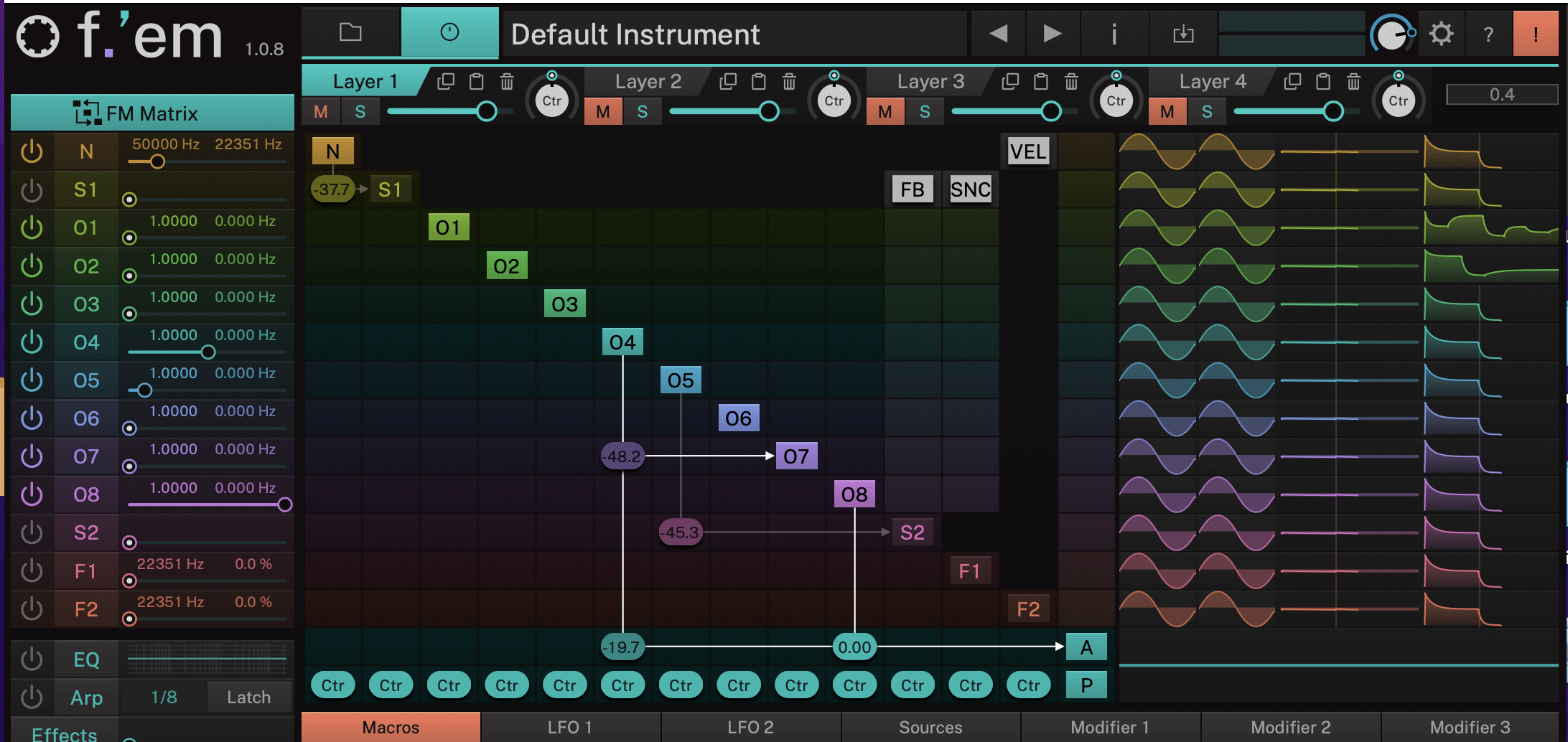
One crucial aspect of FM synthesis that sets it apart from other forms of sound generation is the FM Matrix.
This powerful tool allows you to manage and control the routing of operators, offering flexibility and precision in shaping your sound.
The FM Matrix is essentially a grid that represents the connections between operators, where each row and column corresponds to a specific operator.
By adjusting the values within this matrix, you can define how much modulation is applied from one operator to another.
As well as the overall structure of the modulation network.
Understanding the FM Matrix
To fully harness the power of the FM Matrix, it’s essential to understand its layout and functionality.
Each cell in the matrix represents the modulation amount between two operators: the modulator (row) and the carrier (column).
By adjusting the values in these cells, you can control the depth of the modulation between operators, thereby shaping the harmonic content of the resulting waveform.
For example, if you have a matrix with four operators, you can create a variety of configurations.
From simple one-operator modulation chains to complex networks with multiple interconnected operators.
The FM Matrix enables you to experiment with different routing possibilities, giving you the flexibility to create a vast array of sounds and textures.
Tips for Working with the FM Matrix
- Start simple: When first exploring the FM Matrix, it can be helpful to begin with a simple configuration, such as one operator modulating another. This will allow you to familiarize yourself with the matrix and the impact of modulation on your sound.
- Experiment with different routing: As you become more comfortable with the FM Matrix, try out various routing configurations to see how they affect the sound. This can lead to unexpected and exciting sonic discoveries that would be difficult to achieve with other synthesis methods.
- Balance modulation depth: Be mindful of the modulation depth when working with the FM Matrix. Too much modulation can result in an overly complex and chaotic sound, while too little may not produce the desired effect. Finding the right balance is key to crafting expressive and captivating sounds.
By understanding and mastering the FM Matrix, you’ll unlock a world of creative possibilities in FM synthesis, enabling you to design a wide range of captivating sounds.
Expert Tips to Mastering FM Synthesis
Now that you’ve learned the fundamentals and explored some practical techniques, let’s dive into some expert tips that will help you truly master FM synthesis.
-
Get Creative
When it comes to FM synthesis, experimentation is key.
There are virtually infinite combinations of operators, frequency ratios, envelopes, and modulation depths to explore.
You never know what unique sounds you’ll stumble upon.
Don’t be afraid to try out different configurations and settings, even if they seem unconventional or counterintuitive.
You might discover new sounds and textures that inspire your music in unexpected ways.
Remember, there are no rules in sound design, and sometimes the most interesting results come from breaking the mold.
PRO TIP: If your envelopes are not flexible enough to reproduce the intended shape/movement, don’t hesitate to use automation as an extension of typical envelope shapes.
-
Use Velocity & Aftertouch for Expressive Control

To truly master FM synthesis, it’s essential to harness the power of expressive control.
By using velocity and aftertouch in your sound design, you can create more dynamic and responsive sounds that respond to your playing style.
- Velocity 一 A parameter that represents the speed at which a key is struck on a MIDI controller. By mapping velocity to various parameters in your FM synth, such as the amplitude or modulation depth, you can create sounds that change in character based on how hard you play the keys.
- Aftertouch (pressure sensitivity) 一 An expressive control that allows you to modulate your sound by applying pressure to a key after it’s been struck. By mapping aftertouch to parameters like filter cutoff, pitch, or modulation depth, you can add subtle or dramatic changes to your sound as you play.
By incorporating velocity and aftertouch into your sound design, you can create more expressive and dynamic sounds that come to life under your fingertips.
This not only adds depth and nuance to your music but also makes playing and performing with your FM synth a more engaging and enjoyable experience.
-
Incorporate Presets to Kickstart Your Sound Design
While designing sounds from scratch is an essential skill for mastering FM synthesis, don’t underestimate the value of using presets as a starting point for your sound design.
Presets can serve as excellent learning tools and inspiration for your own creations.
By dissecting and reverse-engineering presets, you can gain insight into how experienced sound designers create specific sounds and apply those techniques to your own work.
You might discover new combinations of operators, frequency ratios, and modulation depths that you hadn’t considered before.
Furthermore, presets can save you time when you’re under a tight deadline or looking for a specific sound quickly.
By starting with a preset that’s close to the sound you’re after, you can make minor tweaks and adjustments to tailor it to your needs without having to build the sound from the ground up.
Remember, presets are not a crutch, but a valuable resource in your FM synthesis toolkit.
Embrace them as a source of inspiration, learning, and efficiency on your journey to mastering FM synthesis.
FM Synthesis: Final Thoughts
FM synthesis is an incredibly versatile and powerful tool for modern music production.
With its unique approach to sound generation and the potential for limitless creativity offered by the FM Matrix, it’s no wonder that FM synthesis continues to inspire producers around the world.
By understanding the fundamentals of FM synthesis and mastering techniques like frequency ratios, modulation depth, and operator routing, you’ll be well-equipped to create an infinite array of sounds.
From classic electric pianos and bell tones to cutting-edge textures and evolving pads, the world of FM synthesis is rich with sonic possibilities.
Now that you’ve unlocked the secrets of FM synthesis, it’s time to dive in, explore, and let your creativity run wild.
In order to do so, make sure to download the Unison Essential MIDI Melodies pack, which contains 12 unique, professionally-crafted MIDI melodies.
Then, use an FM synth to experiment with the operators, envelope values, and more in order to gain a better understanding of how FM synthesis works.
Until next time…







Leave a Reply
You must belogged in to post a comment.